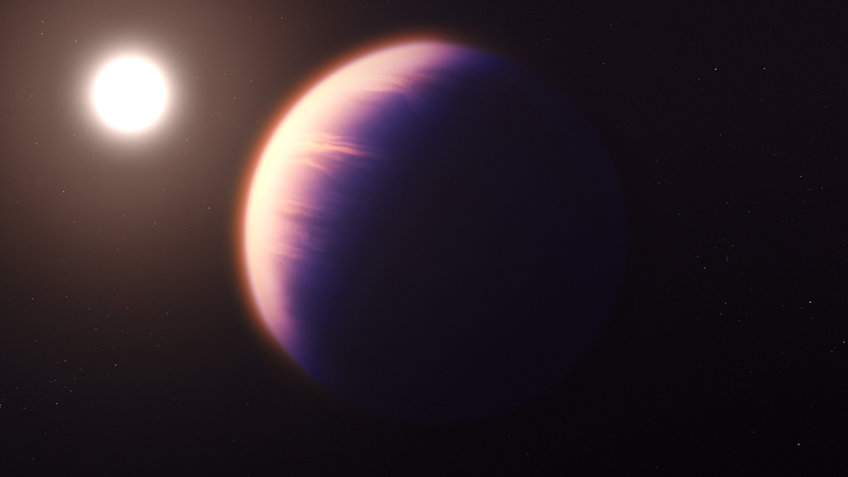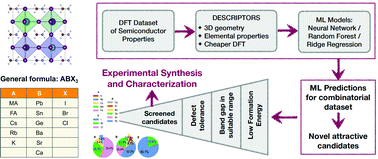ジェームズ・ウェッブ・テレスコープは、太陽系外の惑星の組成や形成に関する知見を提供します。 The James-Webb-Telescope provides insights into the composition and formation of planets outside our solar system.
2022-08-25 マックス・プランク研究所
 Illustration showing what exoplanet WASP-39 b could look like, based on current understanding of the planet. WASP-39 b is a hot, puffy gas-giant planet with a mass 0.28 times Jupiter (0.94 times Saturn) and a diameter 1.3 times greater than Jupiter, orbiting just 0.0486 astronomical units (7,270,000 km) from its star. The star, WASP-39, is fractionally smaller and less massive than the Sun. Because it is so close to its star, WASP-39 b is very hot and is likely to be tidally locked, with one side facing the star at all times. Data collected by Webb’s Near-Infrared Spectrograph (NIRSpec) show unambiguous evidence for carbon dioxide in the atmosphere. At the same time, previous observations from Hubble, Spitzer, and other telescopes indicate the presence of water vapour, sodium, and potassium. The planet probably has clouds and some form of weather but may not have atmospheric bands like those of Jupiter and Saturn. This illustration draws from indirect transit observations from Webb as well as other space and ground-based telescopes. Webb has not captured a direct image of this planet.
Illustration showing what exoplanet WASP-39 b could look like, based on current understanding of the planet. WASP-39 b is a hot, puffy gas-giant planet with a mass 0.28 times Jupiter (0.94 times Saturn) and a diameter 1.3 times greater than Jupiter, orbiting just 0.0486 astronomical units (7,270,000 km) from its star. The star, WASP-39, is fractionally smaller and less massive than the Sun. Because it is so close to its star, WASP-39 b is very hot and is likely to be tidally locked, with one side facing the star at all times. Data collected by Webb’s Near-Infrared Spectrograph (NIRSpec) show unambiguous evidence for carbon dioxide in the atmosphere. At the same time, previous observations from Hubble, Spitzer, and other telescopes indicate the presence of water vapour, sodium, and potassium. The planet probably has clouds and some form of weather but may not have atmospheric bands like those of Jupiter and Saturn. This illustration draws from indirect transit observations from Webb as well as other space and ground-based telescopes. Webb has not captured a direct image of this planet.
© NASA, ESA, CSA, Joseph Olmsted
ジェームス・ウェッブ宇宙望遠鏡は、太陽系外の惑星の大気中に二酸化炭素が存在することを初めて明確に証明した。この観測は、700光年離れた太陽のような星を周るガス惑星について、惑星の組成と形成について重要な洞察を与える。また、この発見は、より小さな岩石質の惑星の薄い大気中の二酸化炭素を検出・測定するウェッブ独自の能力を示しており、『Nature』に掲載されることが決まった。
今回、ウェッブ望遠鏡の比類ない赤外線感度により、この惑星に二酸化炭素が存在することが確認されました。
研究チームは、ウェッブ望遠鏡の近赤外線分光器 (NIRSpec) を使って WASP-39b の観測を行いました。
その結果得られた太陽系外惑星の大気スペクトルのうち、4.1ミクロンから4.6ミクロンにかけてのわずかな輝度上昇は、太陽系外惑星の研究者にとって決して些細なことではなく、非常に重要なものです。これは、太陽系外の惑星で初めて検出された二酸化炭素の、明確で詳細な、議論の余地のない証拠なのだ。
<関連情報>
太陽系外惑星大気に含まれる二酸化炭素の同定 Identification of carbon dioxide in an exoplanet atmosphere
The JWST Transiting Exoplanet Community Early Release Science Team: Eva-Maria Ahrer (1 and 2), Lili Alderson (3), Natalie M. Batalha (4), Natasha E. Batalha (5), Jacob L. Bean (6), Thomas G. Beatty (7), Taylor J. Bell (8), Björn Benneke (9), Zachory K. Berta-Thompson (10), Aarynn L. Carter (4), Ian J. M. Crossfield (11), Néstor Espinoza (12 and 13), Adina D. Feinstein (6 and 14), Jonathan J. Fortney (4), Neale P. Gibson (15), Jayesh M. Goyal (16), Eliza M. -R. Kempton (17), James Kirk (18), Laura Kreidberg (19), Mercedes López-Morales (18), Michael R. Line (20), Joshua D. Lothringer (21), Sarah E. Moran (22), Sagnick Mukherjee (4), Kazumasa Ohno (4), Vivien Parmentier (23 and 24), Caroline Piaulet (9), Zafar Rustamkulov (25), Everett Schlawin (26), David K. Sing (25 and 13), Kevin B. Stevenson (26), Hannah R. Wakeford (3), Natalie H. Allen (13 and 14), Stephan M. Birkmann (27), Jonathan Brande (11), Nicolas Crouzet (28), Patricio E. Cubillos (29 and 30), Mario Damiano (31), Jean-Michel Désert (32), Peter Gao (33), Joseph Harrington (34), Renyu Hu (31 and 35), Sarah Kendrew (27), Heather A. Knutson (35), Pierre-Olivier Lagage (36), Jérémy Leconte (37), Monika Lendl (38), Ryan J. MacDonald (39), E. M. May (26), Yamila Miguel (28 and 40), Karan Molaverdikhani (41 and 42 and 19), Julianne I. Moses (43), Catriona Anne Murray (10), Molly Nehring (10), Nikolay K. Nikolov (12), D. J. M. Petit dit de la Roche (38), Michael Radica (9), Pierre-Alexis Roy (9), Keivan G. Stassun (44), Jake Taylor (9), William C. Waalkes (10), Patcharapol Wachiraphan (10), Luis Welbanks (20 and 45), Peter J. Wheatley (2 and 1), Keshav Aggarwal (46), Munazza K. Alam (33), Agnibha Banerjee (47), Joanna K. Barstow (47), Jasmina Blecic (48), S. L. Casewell (49), Quentin Changeat (50), K. L. Chubb (51), Knicole D. Colón (52), Louis-Philippe Coulombe (9), Tansu Daylan (53 and 54), Miguel de Val-Borro (55), Leen Decin (56), Leonardo A. Dos Santos (12), Laura Flagg (39), Kevin France (57), Guangwei Fu (17 and 13), A. García Muñoz (36), John E. Gizis (58), Ana Glidden (59 and 60), David Grant (3), Kevin Heng (61), Thomas Henning (19), Yu-Cian Hong (39), Julie Inglis (35), Nicolas Iro (62), Tiffany Kataria (31), Thaddeus D. Komacek (17), Jessica E. Krick (63), Elspeth K.H. Lee (64), Nikole K. Lewis (39), Jorge Lillo-Box (65), Jacob Lustig-Yaeger (26), Luigi Mancini (66 and 19 and 67), Avi M. Mandell et al. (32 additional authors not shown)
arXiv Submitted on:24 Aug 2022
Carbon dioxide (CO2) is a key chemical species that is found in a wide range of planetary atmospheres. In the context of exoplanets, CO2 is an indicator of the metal enrichment (i.e., elements heavier than helium, also called “metallicity”), and thus formation processes of the primary atmospheres of hot gas giants. It is also one of the most promising species to detect in the secondary atmospheres of terrestrial exoplanets. Previous photometric measurements of transiting planets with the Spitzer Space Telescope have given hints of the presence of CO2 but have not yielded definitive detections due to the lack of unambiguous spectroscopic identification. Here we present the detection of CO2 in the atmosphere of the gas giant exoplanet WASP-39b from transmission spectroscopy observations obtained with JWST as part of the Early Release Science Program (ERS). The data used in this study span 3.0 to 5.5 {\mu}m in wavelength and show a prominent CO2 absorption feature at 4.3 {\mu}m (26{\sigma} significance). The overall spectrum is well matched by one-dimensional, 10x solar metallicity models that assume radiative-convective-thermochemical equilibrium and have moderate cloud opacity. These models predict that the atmosphere should have water, carbon monoxide, and hydrogen sulfide in addition to CO2, but little methane. Furthermore, we also tentatively detect a small absorption feature near 4.0 {\mu}m that is not reproduced by these models.iv
Comments:
27 pages, 6 figures, Accepted for publication in Nature, data and models available at https://doi.https://doi.org/10.5281/zenodo.6959427
Subjects:
Earth and Planetary Astrophysics (astro-ph.EP)
Cite as:
arXiv:2208.11692 [astro-ph.EP]
(or arXiv:2208.11692v1 [astro-ph.EP] for this version)



